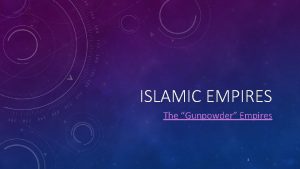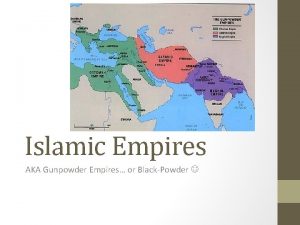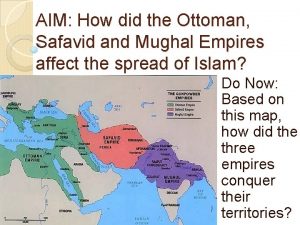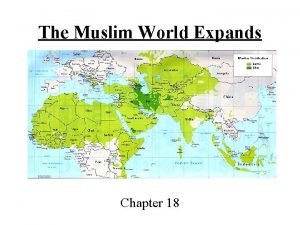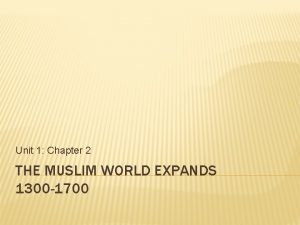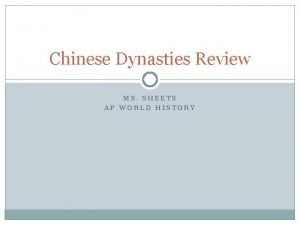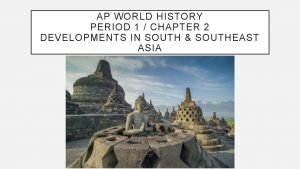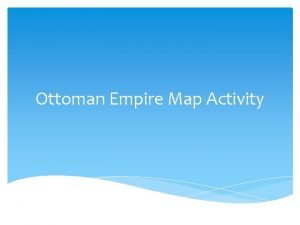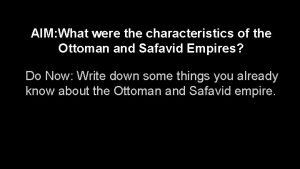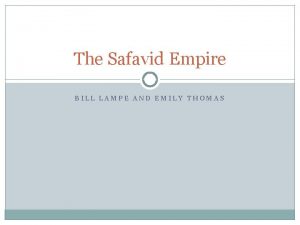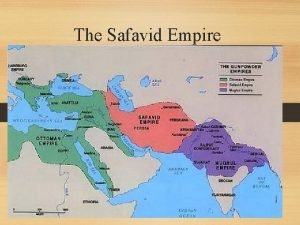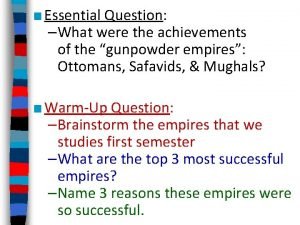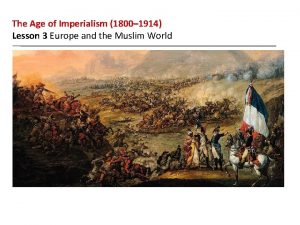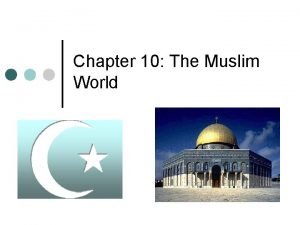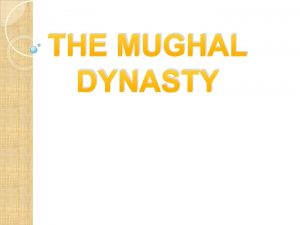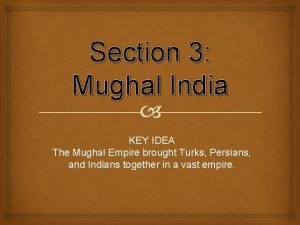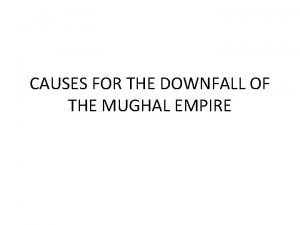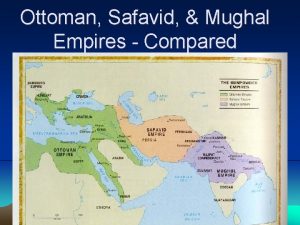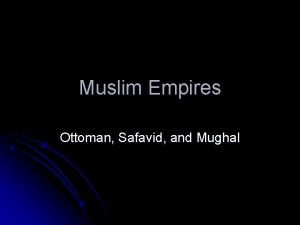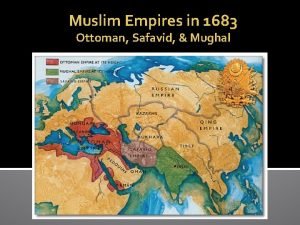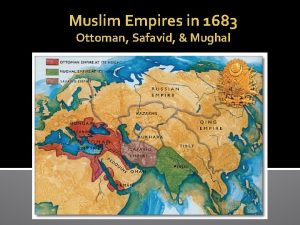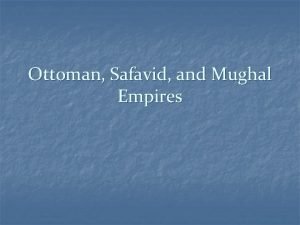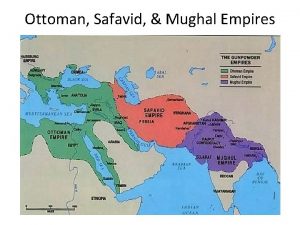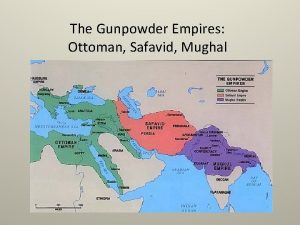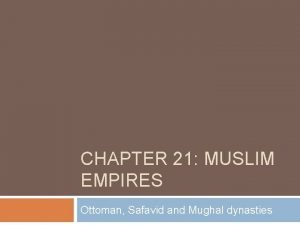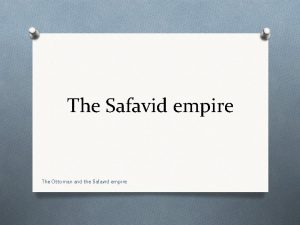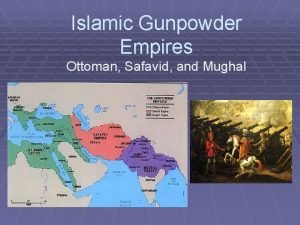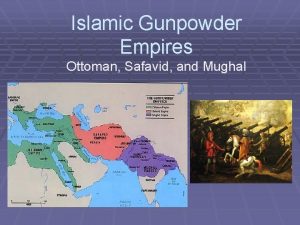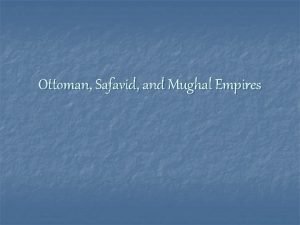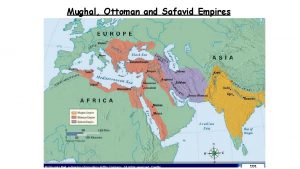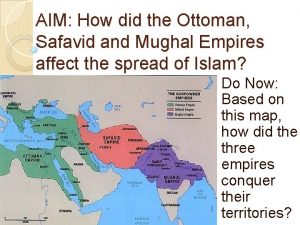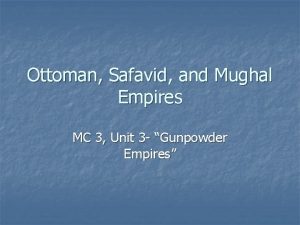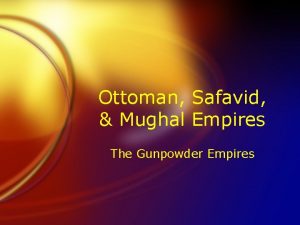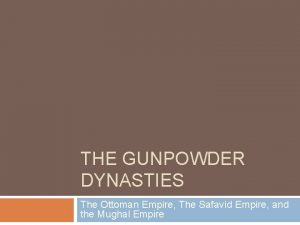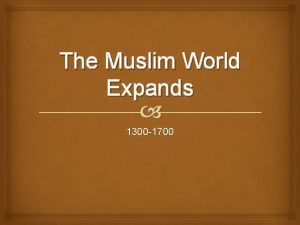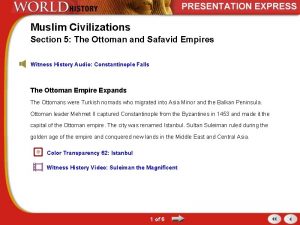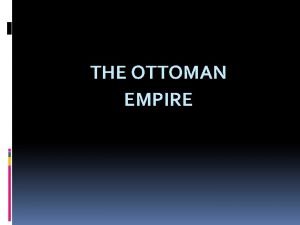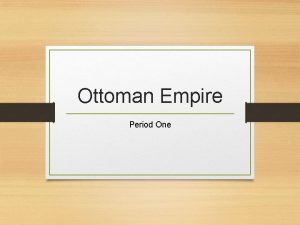The Muslim World Expands Ottoman Safavid Mughal Dynasties

























- Slides: 25

The Muslim World Expands Ottoman Safavid Mughal Dynasties 1300 -1700

The Ottomans named for Osman transform from nomads to an Empire

Constantinople is conquered in 1453 Controlled travel between Asia and Europe Mehmet II opened it to many religions - Jews, Muslims, Turks, non-Turks


Suleiman the Lawgiver rules from 1520 -1566 The greatest of the Ottoman Sultans Expands empire through conquest (Belgrade and Rhodes) Inside the empire he creates an efficient, complex military state to rule over many diverse groups Suleiman creates a law code, reduces bureaucracy and simplifies taxation

Suleiman the Lawgiver Janissaries - trained and educated soldiers from conquered lands with merit based promotion Devshirme- policy of taking boys from non-Islamic families to be trained as Janissaries Freedom of worship – Jews and Christians allowed to practice own religion - pay a tax to do so and lived in communities called millets

Suleiman the Lawgiver Cultural Achievements Studied a variety of subjects including: poetry, history, mathematics etc Mosque of Suleiman - architectural achievement with four schools, a college, a library, a hospital, and a bath

Mosque of Suleiman

The Fall of the Ottomans Ottoman emperors would kill their ablest sons and heirs or keep them uneducated, leading to incompetent rulers When an heir assumed power his brothers were eliminated The Ottoman Empire lasted until WWI but by then was in slow decline from the 1600’s - almost 300 years The Ottoman Empire 1300 -1923 Gea. Cron

The Ottomans and Cultural Diffusion Where did the Ottomans learn about gunpowder? How did the Ottomans treat conquered peoples? How did cultural diffusion affect Ottoman architecture and the arts?

The Safavid Empire

Safavids Iranian origin and claimed to be descendants from Muhammad Shi’ite Muslims - persecuted by Sunni Ottomans Developed strong military to protect self from neighboring empires Is there still conflict today between Shi'ite and Sunni Muslims?

Isma’il Brilliant warrior who seized large tracts of land in 1499 Became religious tyrant killed any non Shi’ite citizen

Shah Abbas – Abbas the Great Takes throne in 1587 Created a culture that drew from Arab, Persian, and Ottoman cultures Reformed armies - One Persian army, one foreign – used modern weapons Punished corruption and promoted merit Welcomed European and Chinese artisans Leads to Rise of Persian Carpets – a national industry


The Safavid Dynasty Declines Quickly Shah Abbas kills and blinds his ablest sons Abbas’s Incompetent grandson leads to the empire’s decline By 1722 the empire is losing land to the Ottomans and Afghans The Empire Falls apart in 1747

The Safavids and Cultural Blending How does Ishma’il differ from Shah Abbas? How is succession to the throne a problem for the Safavids?

The Mughal Empire

The Mughal Empire: Akbar “Great One” - Ruled India from 1556 -1605 Muslim but defended religious freedom Married non Muslims Abolished taxes on non-Muslims Christian tutor

Mughal Empire: Akbar Effective Government Merit based bureaucracy Tax policy - based on earnings Military Conqueror Strong military with modern weapons Put possible enemies (Rajputs) in power to keep control Unified land of 100 million people

Mughal Empire: Akbar Culture Languages : Arabic, Persian, Hindi, Urdu combines to make modern Pakistani language Promoted the arts, literature and architecture drew from western influence in painting (i. e. halos like western saints)

Taj Mahal – Shah Jahan builds a tomb for his wife 1631 -1651

Aurangzeb – Shah Jahan’s rd 3 Imprisons his father and takes over oppressive policies People are suffering paying for wars and monuments Rules from 1658 and 1707 Expands Mughal Empire to its largest size But… Son

Aurangzeb – Shah Jahan’s rd 3 Son Ultimately lost power due to oppressive policies Forced rigid Islamic laws (no drinking, gambling etc) Taxed non-Muslims, destroyed Hindu monuments Led to Rajput/Hindu rebellions European Traders arrive and gain control of key ports

Muslim Dynasties – Had In Common Empire Building - three of the greatest empires in history between 14 th and 16 th centuries Power and Authority – based their power on Islam, strong armies and technology Cultural Diffusion – as powerful societies expand different cultures are blended and new ideas diffused How does cultural diffusion impact societies?
 Ottoman safavid and mughal empire map
Ottoman safavid and mughal empire map How did the ottoman safavid and mughal empires arise
How did the ottoman safavid and mughal empires arise Ottoman safavid and mughal empire map
Ottoman safavid and mughal empire map Ottoman safavid and mughal empire map
Ottoman safavid and mughal empire map Ottoman, safavid, and mughal empires venn diagram
Ottoman, safavid, and mughal empires venn diagram Millet system
Millet system The muslim world expands chapter 18 answer key
The muslim world expands chapter 18 answer key Where was the mughal empire located
Where was the mughal empire located Ap world history chinese dynasties
Ap world history chinese dynasties Bhakti movement definition ap world history
Bhakti movement definition ap world history Ottoman empire map
Ottoman empire map The safavid empire
The safavid empire Safavid empire characteristics
Safavid empire characteristics Where is the safavid empire located
Where is the safavid empire located Achievements of the safavid empire
Achievements of the safavid empire Safavid religon
Safavid religon Safavid empire
Safavid empire Safavid empire achievements
Safavid empire achievements Lesson 3 europe in the muslim world
Lesson 3 europe in the muslim world Chapter 10 the muslim world
Chapter 10 the muslim world Mughal era dance
Mughal era dance Mughal dynasty
Mughal dynasty Mughal empire 1450 to 1750
Mughal empire 1450 to 1750 The mughal empire in india chapter 18 section 3
The mughal empire in india chapter 18 section 3 Dowmfall
Dowmfall Srajan garg
Srajan garg
